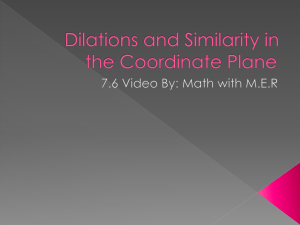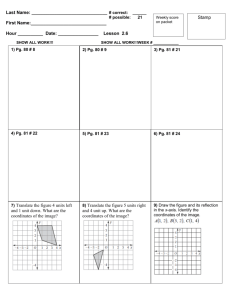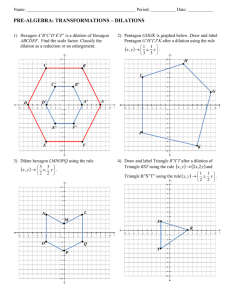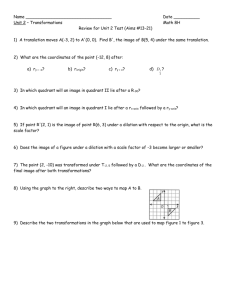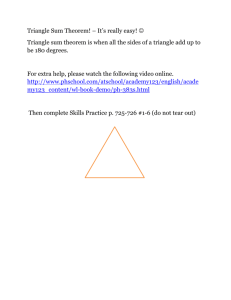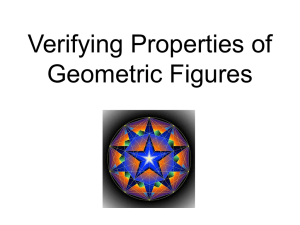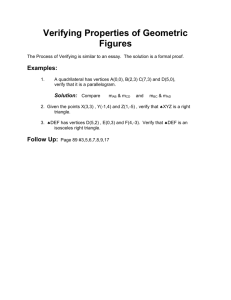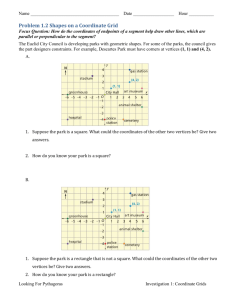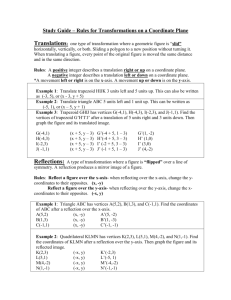Introductory Task - Newark Public Schools
advertisement
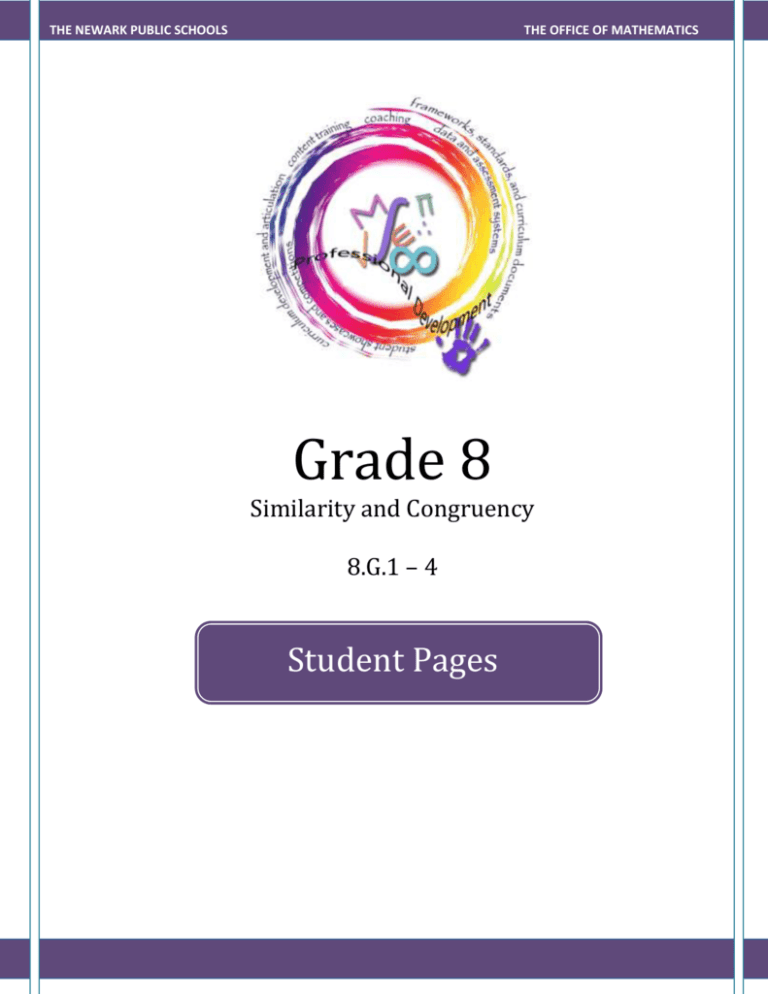
THE NEWARK PUBLIC SCHOOLS THE OFFICE OF MATHEMATICS Grade 8 Similarity and Congruency 8.G.1 – 4 Student Pages PREREQUISITE COMPENTENCIES FOR THIS TASK Graphing in the coordinate plane Identifying the number of lines of symmetry in a given shape Introductory Task 2012 COMMON CORE STATE STANDARDS ALIGNED MODULES Write a rule to describe the translation above CORE STATErule STANDARDS ALIGNED MODULES Explain2012 howCOMMON you arrived at your Define what a translation is Think of two real life situations that model translations. Page 2 of 22 Lesson 1:Guided Practice Introductory Task Guided Practice Collaborative Work Homework Assessment 1. Triangle JKL has vertices J(0,2), K(3,4), and L(5,1). Translate triangle JKL 4 units to the left and 5 units up. a. Draw and label the vertices of the original triangle and its image b. Using arrow notation write a rule to describe the translations c. How do the two triangles compare? 2. Draw the image of triangle ABC after a rotation of 90⁰ about the origin. 3. A rectangle has its vertices at M(1,1), N(6,1), O(6,5) and P(1,5). The rectangle is translated to left 4 units and down three units. a. Graph the rectangle MNOP and M’N’O’P? b. What are the coordinates of M’N’O’P? c. Use arrow notations to write a rule that describes the translation of M’N’O’P’ to MNOP. 4. The points T(0,0), U(-3,0),V(-3,5) and W (2,3) form a quadrilateral. Name the coordinates of the image of quadrilateral T’U’V’W’ after a rotation of 2700 . How do the two quadrilaterals compare? 5. What is the angle of rotation of the figure below? Explain how you found your answer. Page 3 of 22 Lesson 1:Collaborative Work Introductory Task Guided Practice Collaborative Work Homework Assessment Collaborative Work 1. The chessboard below shows for possible moves for the white knight. Write a rule to describe each move as a translation, using the knight’s original position as the origin. 2. What is the angle of rotation, in degrees, that maps A to A’ in the photo of the ceiling fan on the right? 3. Draw the image of triangle ABD after a rotation of the given numbers of degrees about the origin. Explain how you arrived at your answers. a) 180° b) 270° 4. A square has rotational symmetry because it can be rotated 180 degrees so that its image matches the original. Your friend says the angle of rotation is 180° ÷ 4 = 45 °. What is wrong with this statement? 5. Write a rule to describe the translation of G(-5,3) to G’(-1,-2). 6. Match each rule with the correct translation. a. (x,y) (x – 6, y + 2) i) P(4,-1) P’(3,-6) b. (x,y)(x+3, y) ii) Q (3,0) Q’ (-3, 2) c. (x,y) (x-1, y-5) iii) R (-2,4) R’ (1,4) How could you check your answers? Journal Question(s) 1. Suppose you translate a point to the left 1 unit and up 3 units. Describe what you would do to the coordinates of the original point to find the coordinates of the image. Challenge: Graph the equation y=1/2x. Translate the line right 2 units and up four units Page 4 of 22 Lesson 1: Homework Introductory Task Guided Practice Collaborative Work Homework Assessment 1) Parallelogram PQRS is shown on the coordinate plane on the right. a. What are the coordinates of the image of the new image after parallelogram PQRS is translated 6 units to the left and 8 units down? Graph and label the new image on the coordinate plane. b. Write a rule to describe the translation. 2) Find the coordinates of the vertices of each figure after the given transformation. a. rotation of 180° about the origin; E(2,-2), J(1,2), R(3,3), S(5,2) b. translation: 7 units right and 1 unit down; J(-3,1), F(-2,3), N(-2,0) c. rotation 90° clockwise about the origin; B(-2,0), C(-4,3), Z(-3,4), X(-1,4) d. translation: 6 units left and 3 units up; S(-3,3), C(-1,4), W(-2,-1) 3) Rotate the figure the given number of degrees about the origin. List the coordinates of the rotated figure. Page 5 of 22 Lesson 2:Introductory Task – Reflecting Lines Introductory Task Guided Practice Collaborative Work Homework Assessment Introductory Task Line segments AB and CD have the same length. Describe a sequence of reflections that exhibits congruence between them. Commentary: Students' first experience with transformations is likely to be with specific shapes like triangles, quadrilaterals, circles, and figures with symmetry. Exhibiting a sequence of transformations that shows that two generic line segments of the same length are congruent is a good way for students to begin thinking about transformations in greater generality Focus Question(s) How does the line of reflection affect the reflection of a shape? Page 6 of 22 Lesson 2: Guided Practice Introductory Task Guided Practice Collaborative Work Homework Assessment Guided Practice 1. Triangle JKL is shown on the coordinate plane on the right a. Triangle JKL is reflected over the y-axis. On your grid, draw triangle J’K’L’. Be sure to label the vertices b. Triangle J’K’L’ is rotated 90 degrees clockwise about the origin. Draw triangle J”K”L”, Be sure to label the vertices c. Suppose the vertices of J”K”L” are reflected over the y-axis and the reflected over the xaxis. Do the vertices of the resulting triangle have the same coordinates as the vertices of triangle JKL? Show and explain how you got your answer. 2. Quadrilateral BCDE has vertices of B (-4,4) , C(-1,5), D(0,2), E(-2,1) a. Graph quadrilateral BCDE and its image after it is reflected over the line through (1,3) and (1,0). b. Name the coordinates of the vertices B’C’D’E’ 3. Triangle ABC has vertices A(-2,5), B(-2,2), and C (-5,2). If triangle ABC is reflected across the line y=x, what are the new coordinates? Page 7 of 22 Lesson 2: Collaborative Work Introductory Task Guided Practice Collaborative Work Homework Assessment ̅̅̅̅ and its image ̅̅̅̅̅ 1. The coordinates of the end points of 𝑆𝑇 𝑆′𝑇′ are given below 1. W S (2,4) S’ (-2,-4) T (-1,1) T’ (1,-1) What single transformation was used to map ̅̅̅̅ 𝑆𝑇 to ̅̅̅̅̅ 𝑆′𝑇′ ? Explain your answer. 2. A shape was moved from Position A to Position B, as shown below. Describe how the shape was moved from Position A to Position B. 3. The vertices of triangle PQR are P(2,1), Q(6,1) and R (6,3). Graph the image of triangle PQR after its translation using the rule (x,y) (x+3, y-6) and its rotation 90 degrees about the origin. 4. Triangle ABC have vertices at A(-3, -4), B (-2,-3) and C(-4.-1). Graph the image of the triangle after the transformations sequence. Reflection across the line y=1 Rotation 90 degrees about the origin Does the order affect the final image? Explain your answer Journal Question(s) 1) A polygon is reflected in the x-axis and then reflected in the y-axis. Explain how you can use rotations to obtain the same result as this composition of transformations. Draw an example. 2) When you reflect a figure in a line, you can visualize reflecting the entire plane and taking the figure along for the ride. Are any points in the plane unmoved by a reflection? That is, are there any fixed points? Explain.551) Page 8 of 22 Lesson 2: Homework Introductory Task Guided Practice Collaborative Work Homework Assessment Homework 1. Point P(6, 7) and point Q(6, 4) are plotted on the coordinate grid to the right. Point P is rotated 180° clockwise about point Q. What are the coordinates of the image of point P after this rotation? Graph on the coordinate grid. Explain how you found for your answer. 2. a. b. c. On your grid, draw the image of triangle LMN after it is translated 4 units to the left. Label the image PQR. List the coordinates for points P, Q, and R. On your grid, draw the image of triangle LMN after it is translated 6 units up and 3 units to the right. Label the image TUV. List the coordinates for points T, U, and V. On your grid, draw the image of triangle LMN after it is reflected over the x-axis. Label the image XYZ. List the coordinates for points X, Y, and Z. 3. Graph the reflection and identify the new coordinates formed by the polygons using the given line: 4. Graph triangle RST with vertices R(-1,3), S(4,-2), and T(2,-5). Graph the image and identify the new coordinates formed by rotating the triangle about the origin: a) 90⁰ b) 180⁰ c) 270⁰ Page 9 of 22 Lesson 3:Introductory Task – Dialations Introductory Task Guided Practice Collaborative Work Homework Assessment Introductory Task Focus Question(s) How does scale factor affect whether the dilation will be an enlargement or a reduction? Page 10 of 22 Lesson 3:Guided Practice Introductory Task Guided Practice Collaborative Work Homework Assessment Guided Practice 1. Find the image of triangle DEF with vertices D(-2,2), E(1,-1) and F(-2,-1) after a dilation with center D and a scale factor of 2 2. Find the coordinates of the image of quadrilateral KLMN after a dilation with a scale factor of 3/2. 3. Figure TRSV shows the outline of a park. A city planner dilates the figure to show the area of the park that can be used for concerts. Find the scale factor. Is it an enlargement or a reduction? How does the area of Figure TRSV compare to T’R’S’V’ 1 4. You are reducing a digital photo that is 2 in. high and 3 in. wide. If the reduced photo is 1 4 in. high, what is its width? Write your answer as a number in simple form. Make a plan: Draw and label the original photo and the reduced photo next to each other. Label the missing width w. 5. A window on a computer screen is 1 ½ in. high and 2 in wide. After you click the “size 1 1 reduction” button, the window is reduced to 1 8 in high. And 1 2 in. wide. What is the scale factor? 6. The blue figure is a dilation of the original figure. What is the scale factor? Page 11 of 22 Lesson 3:CollaborativeWork Introductory Task Guided Practice Collaborative Work Homework Assessment Collaborative Work 1. A picture frame has an opening that is 12 in by 15 in. If a matting is placed inside the frame to create an opening that is 7 ½ in by 9 3/8 in., what is the scale factor of the reduction? 2. Graph the coordinates of rectangle HIJK with vertices H(1,2), I(1,7), J(14,7), and K(14,2). Label the vertices. a. Find the image of rectangle HIJK after dilation with a scale factor of 0.5 and center H. Label the image LMNO. b. Describe the relationship between the perimeters of rectangle HIJK and of rectangle LMNO. Write a ratio to compare the perimeters c. Describe the relationship between the areas of HIJK and LMNO. Write a ratio to compare the areas. d. What conclusions can you make about the ratio of the areas with a scale factor of 0.5? 3. Draw triangle ABC with the following vertices: A(0,0), B(5,4), and C(6,1). Find the image of triangle ABC after dilation with a scale factor of 2.5. a. What are the coordinates of the image of triangle ABC b. How do the areas of the triangle ABC and its image compare? 4. Jorge is enlarging a digital photo is 4 in. high by 6 in. wide. The enlarged photo is 18 ½ in. high. a. What is its width? b. What is the scale factor? 5. Find the image of triangle ABC at the right after a dilation with the given center and scale factor a. Center B, scale factor of 3 b. Center A, scale factor of ½ 6. Triangle EFG has three angles of 60 degrees and three sides that measure 60 cm each. What scale factor should you use to dilate to triangle A’B’C’ with side lengths of 21 cm. Journal: Suppose you know the coordinates of the vertices of a triangle. Explain how you would find the coordinates of the vertices of its image after a dilation with a scale factor of r. Page 12 of 22 Lesson 3:Homework . Introductory Task Guided Practice Collaborative Work Homework Assessment 1. Using the graph below, identify and label which transformation is a reflection, rotation, translation, and dilation of triangle ABC. Explain how you know. 2. Graph the coordinates of the quadrilateral ABCD. Find the coordinates of its image A’B’C’D’ after a dilation with the given scale factor a) A(2,-2), B(3,2), C(-3,2), D(-2,-2); b) A (6,3), B(0,6),C (-6,2), D(-6,-5); scale factor: 2 scale factor ½ 3. A triangle has coordinates A(-2,-2), B(4,-2) and C(1,1). Graph its image A’B’C’ after dilation with scale factor 3/2. a) Give the coordinates of A’B’C’, b) What is the ratio of the areas of the figures A’B’C’ and ABC. 4. Find the coordinates of the image of ABCD with vertices A(0,0), B(0,3), C(3,3), and D(3,0) after a dilation with a scale factor of 4/3 5. The figure to the right, triangle PQR shows the outline of a playing field. A city planner dilates the design to show the area available for community youth to play sports. Find the scale factor. Is it an enlargement or a reduction? 6. A rectangle is dilated with a scale factor or 0.6. Is the image a reduction or an enlargement? Explain. Page 13 of 22 Lesson 4:Introductory Task – Introductory Task Guided Practice Collaborative Work Homework Assessment Introductory Task On the coordinate plane, draw a quadrilateral with vertices at Q (1,2), R(4,2), S(1,-1), and T(-2,-1). a) What shape is figure QRST? b) Draw the reflection of the figure over the y-axis. Is the image similar to the original figure? c) Dilate the reflected image by a factor of 2 using the origin as the center of dilation. Compare the dilated image with the reflected image and other figure. Which figures are similar? Explain your reasoning. Focus Question(s) How do you identify a similarity transformation in the coordinate plane Page 14 of 22 Lesson 4: Guided Practice Introductory Task Guided Practice Collaborative Work Homework Assessment Guided Practice 1. Given the coordinates A (1,1) B(5, 1) C ( 5, 4) and D (1,4) a. Connect the points and record the area and perimeter of the figure b. Reflect quadrilateral ABCD over the y-axis and record the new coordinate points c. Translate the new quadrilateral 3 units to right and 4 units up. Record the new coordinates. d. Triple the lengths of each side, give the new coordinates. What is the new area and perimeter of the larger quadrilateral? Is it similar, by definition to the smaller quadrilateral? 2. Graph a quadrilateral with vertices at A(-1,1), B(1,1),C(3.-1), and D(1,-1) a. Reflect it over the x-axis and record the new coordinate points b. Dilate the new quadrilateral by a factor of 3 using the origin as the center of dilation c. Which of the figures are similar? Explain your reasoning? 3. Coordinates of the vertices of a pre-image and image figure are given. Describe the transformations that move the first figure onto the second. a. O(0,0), B(0,3), C(2,0); O(O,O), D(O,-6), E(4,0) b. A(-6,0), B(0,6),C(9,0),D (0,-15); W(O,-2),X(-2,0), Y(0,3), Z(5,0) 4. The coordinates of the vertices of a triangle ABC and its image triangle DEF are given. Are there a series of transformations that move triangle ABC onto triangle DEF. A(1,1), B(22,2), C(2,2); D(2,22) E(24,24), F(4,24) 5. Rectangle PQRS is transformed to rectangle P’Q’R’S’ as shown on the graph below: a. Describe a sequence of transformations to map rectangle PQRS to rectangle P’Q’R’S’ b. Identify all congruent lines and angles c. Can you perform a sequence of translations, reflections, rotations, or dilations that are not congruent to the first? Explain Page 15 of 22 Lesson 4:Collaborative Work Introductory Task Guided Practice Collaborative Work Homework Assessment 1. Given points A (1, 2), B (1, 4), and C (4, 4): a. Connect the points and record the area and perimeter of the figure. b. Translate triangle ABC 6 units to the left and record the new coordinate points. c. Reflect the new triangle over the y-axis and record the new coordinate points. d. Rotate the new triangle about the origin 90 degrees clockwise and record the new coordinates. e. Double the lengths of each side, give the new coordinates. What is the new area and perimeter of the larger triangle? Is it similar, by definition, to the smaller triangle? 2. A fractal called the Sierpinksi triangle can be imagined by thinking of an infinite sequence of stages, the first of which are shown below. Calculate the side lengths of the light blue triangles in Stages 1,2, and 3. Then describe the 3 dilatations you can apply to any stage to generate the next stage 3. Use transformations to explain why pentagons EFGHD and RSTUV are not similar 4. Draw triangle EFG with vertices at E(-2,3), F(0,4) and G(0,0) and triangle JKL with vertices at J(3,-2), K(4,-4) and L(0,-4). a. Describe a sequence of transformations to obtain triangle JKL from triangle EFG b. Describe a different sequence of transformations that you used in part a. to obtain triangle JKL from triangle EFG c. Do the transformations you chose affect the congruence of line segments or angles? Explain. Journal Question(s) 1. In a coordinate plane, does the order of transformations affect similarity? Explain. Page 16 of 22 Lesson 4: Homework Introductory Task Guided Practice Collaborative Work Homework Assessment Homework 1. The vertices of triangle ABC are A (2, 4), B (6, 8), and C (11, 3). Triangle ABC is translated 5 units down into triangle A'B'C' and reflected in the y−axis into triangle A''B''C''. What are the coordinates of the vertices of triangle A''B''C''? 2. Starting with the smallest square, describe the transformations that were used to make the drawing on the left. 3. Using the diagram on the right answer the following question: a) Describe the sequence of transformations that maps trapezoid WXYZ to trapezoid W”X”Y”Z” ̅̅̅̅̅. Which other line segments are b) Find the length of 𝑊𝑋 congruent to 𝑊𝑋? c) Does a sequence of transformations maintain congruence? Use the lengths of line segments to justify your answer. d) Dose a sequence of transformations maintain congruency of angles? 4. Verify that the two figures in the graph are similar by describing a composition of transformations, involving a dilation then a translation, that maps triangle DEF to triangle D’E’F’ . 5. Coordinates of the vertices of a pre-image and image figure are given. Describe the transformations that move the first figure onto the second. a. O(0,0), B(0,8), Q(6,0); O(O,O), R(4,0), E(0,-3) b. J(-4,0), K(0,4),L(6,0); L(6,0),M(-0,6), N(-9,0) Page 17 of 22 Lesson 5:Golden Problem Introductory Task Guided Practice Collaborative Work Homework Assessment Golden Problem – 1 Samantha and Mario were both given the coordinates: P(-4, 4), Q(-5, 4), R(-6, 2) and S(-2, 2) for parallelogram PQRS. They were told to translate the parallelogram: (x, y)(x + 6, y + 1) and then reflect it over the x –axis, and label the new parallelogram: P’Q’R’S’. Samantha said her coordinates are: P’ (5, -5), Q’(1, -5), R’(0, -3) and S’(4, -3). Mario said his coordinates are: P’(5, -5), Q’(1, -5), R’(2, -3) and S’(6, -3). Who has the correct coordinates for parallelogram PQRS? Explain what mistake(s) the student made who had the incorrect coordinates. Page 18 of 22 Lesson 5:Golden Problem Introductory Task Guided Practice Collaborative Work Homework Assessment Golden Problem – 2 Given: ABC, A(4, 8), B (6, 14), C (10, 12) a) Reflect ABC across the x-axis. Label that reflection A’B’C’. What are the coordinates of A’, B’, C’? 1 b) Use a dilation of A’B’C’ with a scale factor of to find 2 A”B”C”. What are the coordinates of A”, B”, C”? c) Find the coordinates of the vertices of A’”B’”C’” by translating A”B”C”: (x, y)(x + 4, y – 5), then reflect it over the y-axis. Page 19 of 22 *Grade 8 Required Fluency: Solve simple 2 x 2 systems by inspection Systems of linear equations can also have one solution, infinitely many solutions or no solutions. Students will discover these cases as they graph systems of linear equations and solve them algebraically. A system of linear equations whose graphs meet at one point (intersecting lines) has only one solution, the ordered pair representing the point of intersection. A system of linear equations whose graphs do not meet (parallel lines) has no solutions and the slopes of these lines are the same. A system of linear equations whose graphs are coincident (the same line) has infinitely many solutions, the set of ordered pairs representing all the points on the line. By making connections between algebraic and graphical solutions and the context of the system of linear equations, students are able to make sense of their solutions. Students need opportunities to work with equations and context that include whole number and/or decimals/fractions. Examples: • Find x and y using elimination and then using substitution. 3x + 4y = 7 -2x + 8y = 10 • Plant A and Plant B are on different watering schedules. This affects their rate of growth. Compare the growth of the two plants to determine when their heights will be the same. Page 20 of 22 Let W= number of weeks Let H= height of the plant after W weeks W 0 1 2 3 Plant A H 4 (0,4) 6 (1,6) 8 (2,8) 10 (3,10) W 0 1 2 3 Plant B H 2 (0,2) 6 (1,6) 10 (2,10) 14 (3,14) Given each set of coordinates, graph their corresponding lines. *Fluent in the Standards means “fast and accurate”. It might also help to think of fluency as meaning the same thing as when we say, that somebody is fluent in foreign language; when you’re fluent, you flow. Fluent isn’t halting, stumbling,or reversing oneself. Assessing fluency requires attending to issues of time (and even perhaps rhythm, which could beachieved with technology). Source: http://www.sde.idaho.gov/site/common/mathCore/docs/mathStandards/MathGr8.pdf Page 21 of 22 Grade 8 Fluency Problems 1. Tanisha and Rachel had lunch at the mall. Tanisha ordered three slices of pizza and two colas. Rachel ordered two slices of pizza and three colas. Tanisha's bill was $6.00, and Rachel's bill was $5.25. What was the price of one slice of pizza? What was the price of one cola? 2. When Tony received his weekly allowance, he decided to purchase candy bars for all his friends. Tony bought three Milk Chocolate bars and four Creamy Nougat bars, which cost a total of $4.25 without tax. Then he realized this candy would not be enough for all his friends, so he returned to the store and bought an additional six Milk Chocolate bars and four Creamy Nougat bars, which cost a total of $6.50 without tax. How much did each type of candy bar cost? 3. Sal keeps quarters, nickels, and dimes in his change jar. He has a total of 52 coins. He has three more quarters than dimes and five fewer nickels than dimes. How many dimes does Sal have? 4. Ramón rented a sprayer and a generator on his first job. He used each piece of equipment for 6 hours at a total cost of $90. On his second job, he used the sprayer for 4 hours and the generator for 8 hours at a total cost of $100. What was the hourly cost of each piece of equipment? 5. At a concert, $720 was collected for hot dogs, hamburgers, and soft drinks. All three items sold for $1.00 each. Twice as many hot dogs were sold as hamburgers. Three times as many soft drinks were sold as hamburgers. Find the number of soft drinks sold . 6. Solve the linear system: 𝑥 + 4𝑦 = 16 −𝑥 + 3𝑦 = −2 7. Solve the linear system: 2𝑥 + 3𝑦 = 12 4𝑥 + 𝑦 = 14 8. Solve the linear system: 3𝑥 + 4𝑦 = 1 6𝑥 + 5𝑦 = −1 9. Solve the linear system: 𝑦 − 6𝑥 = 2 𝑦 = 6𝑥 + 5 10. Solve the linear system: 2𝑥 − 𝑦 = 8 2𝑥 + 2𝑦 = 14 Page 22 of 22
